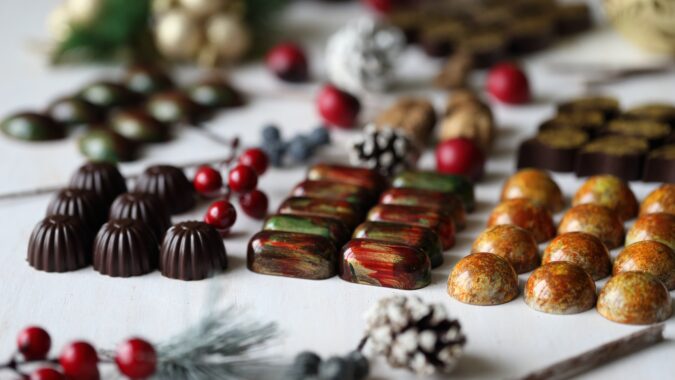Around 4 million Christmas dinners end up in the bin in the UK every year.
Christmas is one of the most anticipated times of the year for many people. Unfortunately, it’s also the most wasteful period with 270,000 tons of festive food disposed of despite being edible. All festive foods that get thrown away every year amount to filling up 7 million bins.
A significant amount ends up in landfill where it rots and releases methane, which contributes to global warming. Yet, there’s a lot people can do to avoid this. To help Britons make more sustainable decisions this Christmas, we’ve put together 6 easy tips to reduce waste food this festive season.
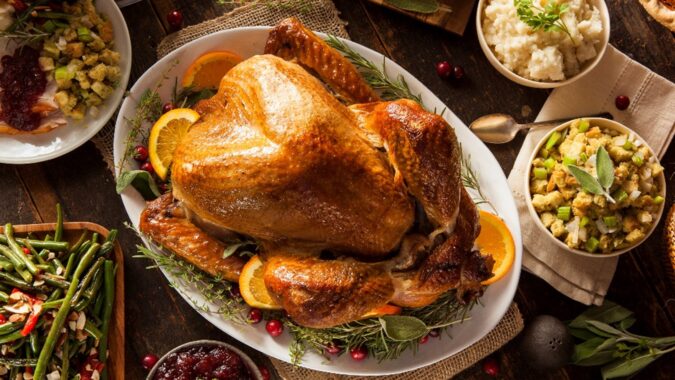
How far will our Christmas
dinner waste take us?
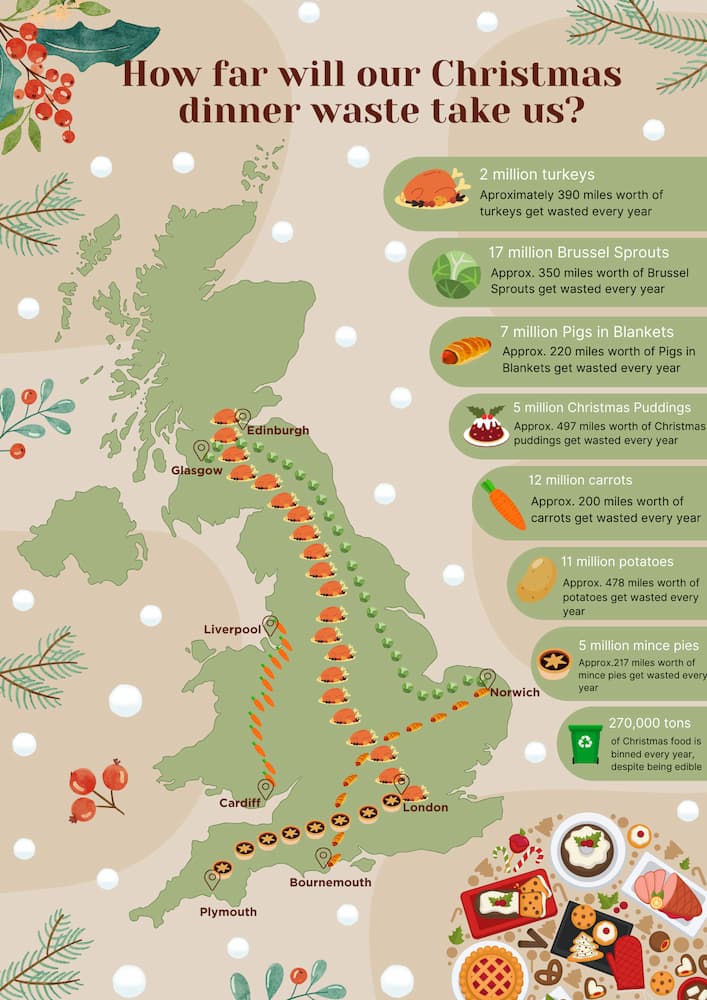
1. Turn your leftovers into soup
One of the easiest and most delicious ways to reuse your Christmas leftovers is by transforming your remaining vegetables, meats, and even grains into hearty soups or stews. It’s a great way to use up odds and ends that might otherwise be thrown away.
2. DIY a vegetable stock
If there isn’t enough left to turn leftovers into soup, consider creating your very own vegetable stock. Vegetable scraps like onion ends, carrot peels, and herb stems can be collected and used to make a flavourful vegetable stock, reducing waste and adding a homemade touch to soups and stews.
3. Make candies out of excess fruit
If you have a surplus of fruits, consider making jams, jellies, or chutneys. For a particularly big excess of oranges, here’s a super tasty dessert you can make easily: just boil the orange peels for 10 minutes, soak them in a new bowl of water overnight, then move them to a pan, add sugar and orange juice (vanilla optional).
Stir and simmer over medium-low heat for 25 minutes, then remove them and let them dry on a rack. Once dried, coat them with more sugar and enjoy the sweet snack! The full recipe can be found here.
4. Revive stale bread
Turn stale bread into croutons for salads, breadcrumbs for coatings, or even a bread pudding. This is a simple way to give new life to bread that might otherwise be discarded. Another delicious option is to make bread pudding, where the stale bread’s ability to absorb flavours and custard makes for a rich, delightful dessert.
5. Use food scraps as compost
People and animals aren’t the only ones that love to feast on delicious Christmas dinners, your garden plants will also love the leftovers. Bits of fruits, vegetables, peelings and even turkey can be added to your compost pile – just ensure you cut it up first to help the decomposition process.
6. Donate what you can
If you have any leftover Christmas foods like biscuits, cakes, or mince pies that are still packaged, they make great donations for food banks. For the turkey, potatoes, and vegetables you no longer need, consider taking them to an animal shelter to feed the less fortunate dogs and kittens.
Reduce your Christmas food waste
Mark Hall, Director at Business Waste, says:
“It’s really unfortunate to see tons of Christmas food being wasted every year, with huge amounts ending up in landfill. There are plenty of ways we can still enjoy all the Christmas festivities in more sustainable ways.
If we all try to implement at least a few of the tips shared above, collectively, we could help reduce this year’s Christmas waste.”
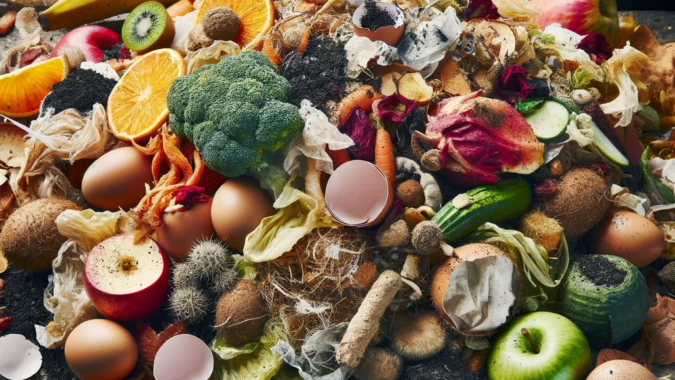
Christmas is the season of giving. But that doesn’t mean presenting your binmen or waste collection company with gifts of extra rubbish to remove this year. It happens though, as UK homes create almost a third more waste over the festive period – and businesses aren’t much better.
For example, around 227,000 miles of wrapping paper and 270,000 tons of food are chucked out every year at Christmas. It’s enough to turn Rudolf’s nose red with anger. Check out our Christmas waste facts for more shameful stats about how much rubbish we churn out every holiday season.
There are many ways to be sustainable at Christmas and give back to the environment. Your decorations, food, and celebrations can be as green as one of Santa’s elves’ outfits with a little effort. Use these sustainable Christmas ideas to enjoy the most wonderful time of the year in an eco-friendly way.
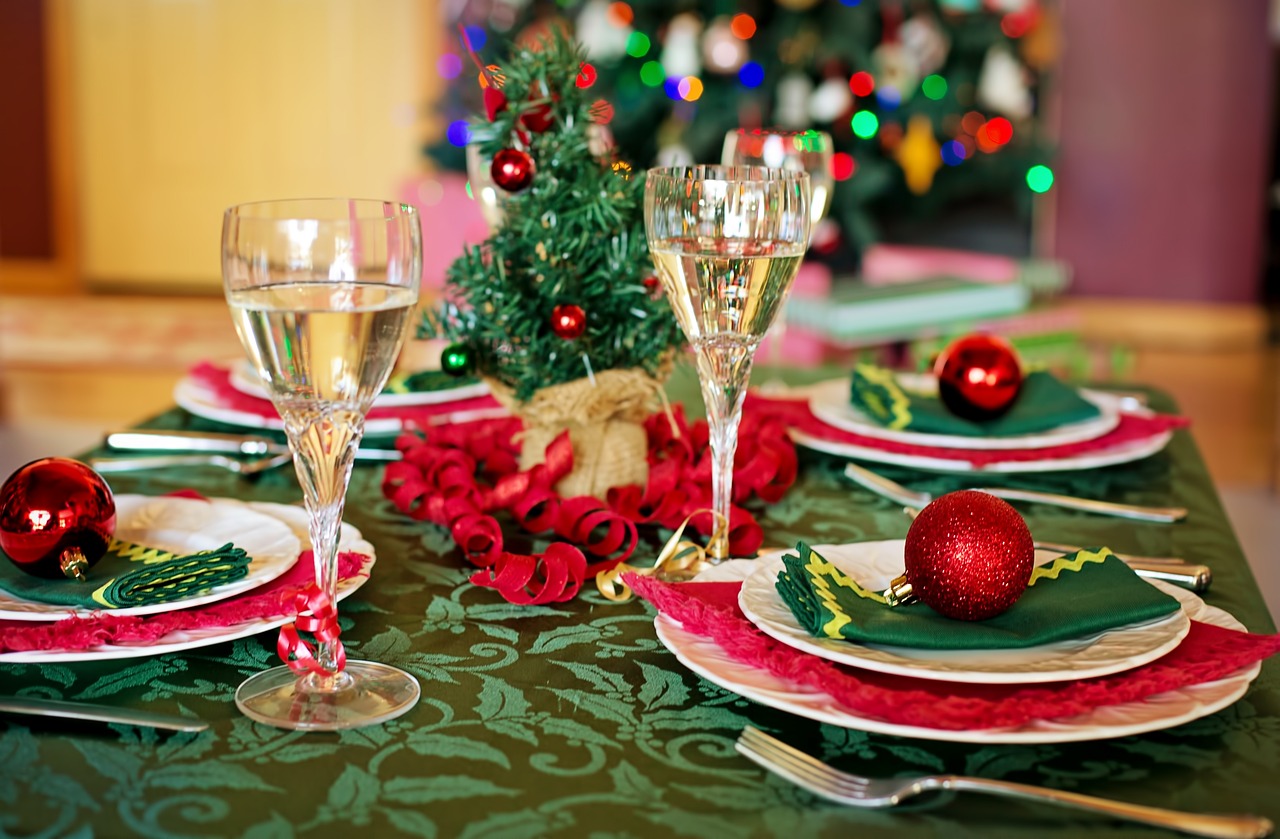
Buy sustainable Christmas trees
The most sustainable Christmas trees are real ones grown locally in the UK. Once cut a new tree can be planted and grown, which is highly sustainable. Ones sourced locally require less transport, fuel, and carbon emissions too. You should check if any tree is from a sustainable forest (or FSC-certified) before you buy.
Other sustainable Christmas tree ideas include renting a real tree rather than buying one. This can be cost-effective and ensures the tree is replanted in the new year. The tree can have a positive impact on the environment and wildlife throughout the year and be used again next Christmas.
What you do after Christmas with your tree is vital for sustainability. Real trees take 10 to 12 years to grow so it’s ideal to replant them in your garden or pass them on to a certified forest. If you have an artificial one, hold onto it and reuse it in the future, as many are plastic and hard to recycle due to containing a combination of materials.
Select sustainable Christmas gifts
In the UK we spend more than £20 billion on Christmas presents every year. Unfortunately, plenty aren’t that sustainable due to packaging and the products themselves. Greater awareness and eco-focus mean there are more options available to buy sustainable Christmas gifts and ideas for creating your own.
Wrapping paper, tags, and bags also contribute to how sustainable any Christmas presents you give out are. Use our tips to reduce Christmas wrapping paper waste. Reusing paper from last year, sourcing recyclable wrapping paper, and using reusable bags are simple steps towards sustainability.
Consider sustainable Christmas cards
It’s estimated that we send around eight billion Christmas cards in the UK every year. That’s an awful lot of trees chopped down for the paper and card to make them all. Most Christmas cards are recyclable and therefore fairly sustainable, although those featuring glitter, glue, and plastic are trickier to recycle.
Recycling Christmas cards also requires energy and effort, so a more sustainable option can be to consider sending an e-card or simply don’t bother this year. Finding a cute Christmas picture and sending it to friends and family over social media, WhatsApp, or email could suffice and use zero paper and card.
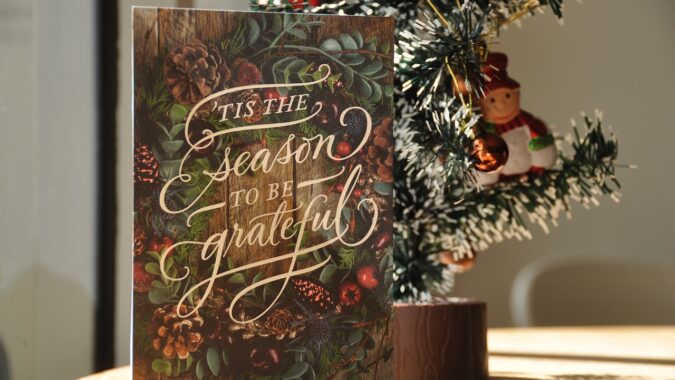
Throw a sustainable Christmas party
The Christmas party season is a fun time that leads to plenty of excess – eating, drinking, and dancing more than usual. Often it includes creating excess waste too, with loads of leftover food, decorations thrown away, and plastic plates and cups binned. But it doesn’t have to be that way.
A little bit of preparation can create a sustainable party whether you’re planning the work Christmas do or arranging a festive get-together at home for friends and family. Considerations covering the food, decorations, activities, and recycling can help reduce how much waste your celebrations create and ensure there’s less cleaning up afterwards.
Source a sustainable Christmas jumper
As most people only wear Christmas jumpers in December they’re not always the most sustainable clothing items. Keep yours for a few years and it can be better for the environment though. A few ways to source a sustainable Christmas jumper include to:
- Wear last year’s Christmas jumper (if it still fits!)
- Knit your own using locally sourced wool
- Buy a second-hand Christmas jumper from a charity shop or online
- Upcycle an old jumper with a few festive additions
- Go to a clothes swap
Put up sustainable Christmas decorations
Tinsel is terrible for the environment as the PVC film and metallic coating can’t be separated and recycled. Thankfully, there are many eco-friendly alternatives for decorating your home or workplace in December. These include making a sustainable Christmas wreath from natural items to stringing up solar lights outside or on your Christmas tree.
Handmade decorations, sustainably sourced baubles, and table decorations – including sustainable Christmas crackers – are essential. Avoid plastic decorations and those that use a combination of materials as they’re harder to recycle. One of the most sustainable actions is to simply use the same decorations from last year and store them for many years to come.
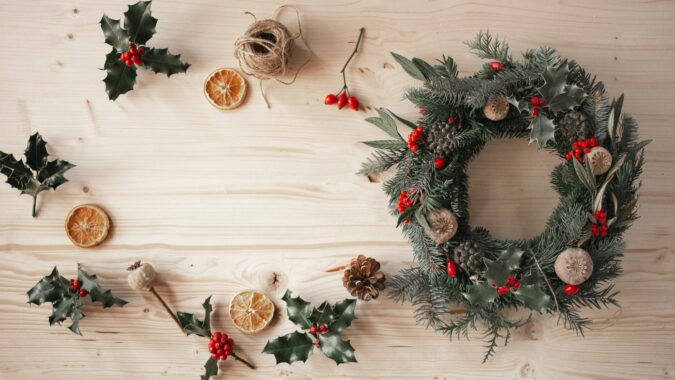
Serve sustainable festive food
The equivalent of around seven million bins full of waste food are produced in the UK over Christmas every year. That includes millions of mince pies, sprouts, turkeys, Christmas cakes and pudding being thrown out. Smart shopping, portion control, saving and using leftovers in other recipes can all help reduce food waste for your festive feasting.
Buy a sustainable advent calendar
There’s a hidden cost of advent calendars, as many include single-use plastics that are bad for the environment. Sweet and chocolate wrappers aren’t always recyclable and many end up in landfill. But advent calendars are great for getting kids (and some adults) into the Christmas spirit.
Buy or make a sustainable advent calendar that has as little packaging as possible. Plenty are made purely from cardboard that’s easy to recycle. Alternatively, create your own for a waste-free option. It’s important you recycle or reuse the advent calendar next year after the big day for a fully sustainable solution.
Ways to be more sustainable at Christmas
Looking for more ways to reduce waste and celebrate a sustainable Christmas this year? We’ve put together a range of expert guides with tips and advice about reducing waste at home and work this festive season.
Stringing up Christmas lights creates a warm and festive atmosphere in any office, shop, restaurant, home, or garden. But it’s always a bit sad when the holiday season’s over and you’ve got to take them down without getting too tangled up. The best, most sustainable thing to do is keep them for next year.
Fairy and Christmas tree lights can break, stop working, or you just might not need them anymore. When this happens it’s important you don’t throw them away. Instead, there are many more eco-friendly options to recycle Christmas lights that have been in your tree, decorating the office walls or hotel lobby.
Here we run through all your options whether you’ve got old Christmas lights that don’t work, haven’t got enough storage space to keep them until next year, or simply fancy some new lights for your tree.
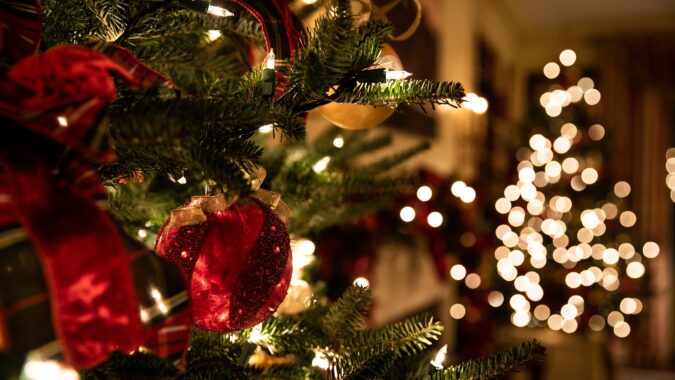
Can you recycle
Christmas lights?
Old Christmas lights are a type of Waste Electrical and Electronic Equipment (WEEE waste). This means you can and should recycle Christmas lights and not throw them away with general waste that sends them to landfill. They class as small electrical items and can be recycled alongside similar waste.
You can recycle old Christmas lights in a commercial WEEE bin at your business or visit your local household waste recycling centre to recycle domestic fairy lights. The process to recycle Christmas lights is similar to other electrical items. The lights are broken down into their component parts and recycled with the relevant waste streams – such as the glass bulb, metal wiring, and plastic coating.
How to recycle
Christmas lights
Recycling Christmas lights is fairly straightforward, but it depends on the type of bulbs they have. If you have old Christmas lights with incandescent bulbs, then you should remove these from the light string first and recycle the light bulbs separately. For fairy lights with LED bulbs, you can recycle the light string as one electrical item.
Arrange delivery and collection of WEEE bins to your premises with Business Waste. We can provide free bins of many sizes for you to fill with electrical waste including old Christmas lights. Our licensed waste carriers will collect and transport the bins to a nearby waste management facility, where the lights will be recycled.
To recycle Christmas lights at home the easiest way is to visit your local household waste recycling centre. There should be a section for electrical items where you can recycle them. You should not throw Christmas lights away in your general waste or household recycling bin.
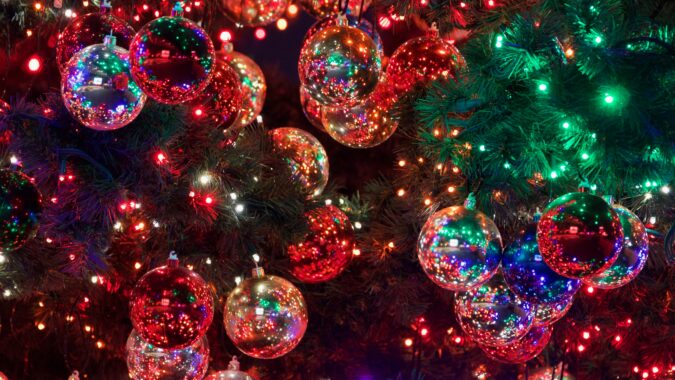
How to dispose of
old Christmas lights
If your old Christmas lights still work, then there’s no point throwing them away. Instead, extend their life by giving them to a friend or family member who can use them, or donate to a charity shop. Consider local schools, community centres, or anywhere else that could put them to good use and offer them for free.
Should you want to make a bit of money, you can always try and sell your old Christmas lights online. eBay, Gumtree, and Facebook Marketplace are common sites where you can set your own price to sell locally. This should ensure they continue to be used rather than end up in landfill.
What to do with old
Christmas lights that don’t work
You can recycle old Christmas lights that don’t work either by arranging delivery and collection of WEEE bins to your workplace or at a local household recycling centre. Recycling Christmas tree lights still uses energy, so there are other options to prolong the life of any old festive fairy lights, such as:
- Make some repairs – if you’ve had the lights for a few years, it could be that the bulbs just need changing. Replace them and if they light up again then you can keep using them. Another problem could be the wiring, which you might be able to pass on to an electrician to fix.
- Repurpose the lights – even when they don’t light up Christmas lights can make a decorative festive addition to a wreath or garland. When only a few bubs have burnt out you can also put the light string in an empty jar or vase to create a new illuminated Christmas decoration.
- Paint the bulbs – should your Christmas lights be at the end of their life you could paint over all the bulbs to upcycle them. Use festive colours like red and green along with adding glitter to keep their sparkle. Then add to a wreath or just put them up in your office or home for an energy-free festive decoration.
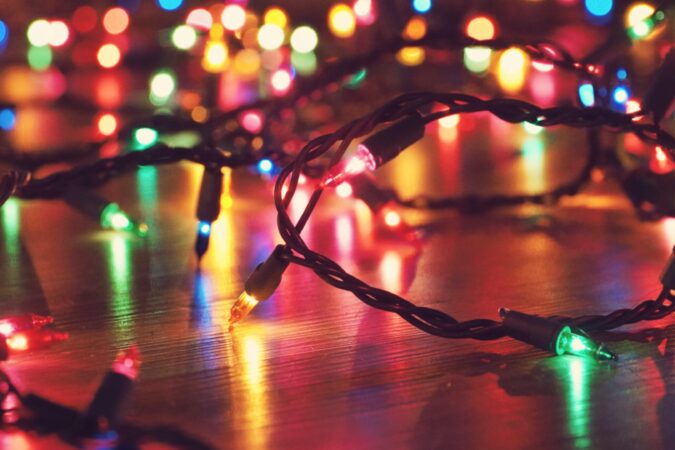
Where can I recycle
old Christmas lights?
Where to recycle old Christmas lights depends on whether you’re getting rid of them from your business or home. Recycling Christmas tree lights and other illuminations from your workplace means it classes as commercial waste and must be removed by licensed waste carriers. At Business Waste we can arrange delivery of free bins to store your lights for recycling.
You just pay for collection and our licensed waste carriers will remove the bins at an agreed time and take them to a relevant facility for recycling. For homes, you can check your local council’s recycling collection services or visit your nearest household recycling centre to recycle Christmas lights.
As well as Christmas tree lights recycling, the festive season can create lots more different types of waste. We’ve got extensive guides to inform you of how best to reduce, reuse, and recycle all your Christmas waste.
The good old days of traditional card advent calendars are pretty much over. Pulling back a little paper door and seeing an image of a donkey in a stable just doesn’t cut it for kids these days. They need advent calendars packed with chocolate, sweets, and toys. The problem is the extra plastic waste modern advent calendars creates.
And in recent years there’s been a growing trend for more outlandish advent calendars aimed at big kids (adults) as well. Advent calendars for beer, gin, coffee capsules, beauty products, chili sauce, even pork scratchings, all exist. These also introduce extra packaging and materials that make recycling advent calendars tricky.
There are solutions with many sustainable and plastic free advent calendars available, as well as ways to reduce the waste leftover from any advent calendar you or your children have this year. Learn how to recycle and reuse advent calendars this festive season.

Advent calendar facts
There are plenty of advent calendar facts out there about how it came to be a thing and where the biggest or smallest ever novelty advent calendar was made. But what about the waste they create? It’s not just a modern concern – during World War Two the production of advent calendars was stopped to save paper.
You might think their production should be stopped again (or at least changes made to advent calendar packaging) when you read these facts about the advent calendar and the waste it creates:
- Around 5 million advent calendars contain single-use plastics.
- The average traditional chocolate advent calendar is made from 7g of paper, 21.61g of PET plastic and 3.22g of aluminium.
- An advent calendar has around 38 times as much packaging per gram of chocolate compared to a standard chocolate bar.
- There’s also about 12 times as much plastic in an advent calendar compared to a regular bar of chocolate.
- The first advent calendar was produced in 1851 by hand and made from wood – much more sustainable than many modern ones.
- It wasn’t until around 1908 that the idea for a printed advent calendar was born.
Can advent calendars be recycled?
Traditional advent calendars are made from a combination of different materials. Separate the advent calendar and you can recycle the outer cardboard box in your domestic recycling bin. Check the plastic tray for a number and see if that type of plastic is accepted in your household recycling bin.
If the plastic tray is made from PET (1), HDPE (2), or PP (5) then there’s more chance of it being recyclable. This needs to be clean and dry to recycle though. Plastic trays from advent calendars made from other plastic types are less likely to be recyclable and should be disposed of with general waste.
The foil from advent calendars is also recyclable but it must be clean too. If there are bits of chocolate stuck to it this could contaminate the load. So, while you might not be able to recycle a complete advent calendar whole, breaking it down into recyclable parts offers the next best solution.
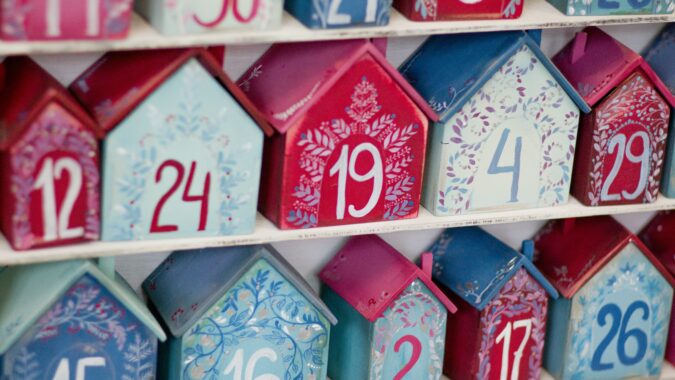
How to recycle an advent calendar
Once you’ve scoffed the last chocolate, built the last LEGO toy, or necked the final mini gin from your advent calendar (we won’t judge that it’s 9am on Christmas Day), you’ll want to throw away the box. But don’t just chuck it in with your general waste or recycling bin. There are three simple steps to recycle your advent calendar:
- Separate the advent calendar – most advent calendars are made from a mix of materials. Split them up into the cardboard, paper, plastic, foil, and any other materials for recycling and disposal with their relevant waste streams.
- Check and clean – check if the materials are recyclable (especially any plastics), then remove any food, dirt, or other contaminants and ensure it’s dry.
- Recycle – place the waste in your domestic recycling bin if it’s a type that’s accepted or in a specific cardboard recycling or plastic waste bin.
What can I do with an empty advent calendar?
If you find some of the materials in your empty advent calendar aren’t recyclable, don’t despair. There are many things you can do with the materials to reuse them and ensure it ends up being a more sustainable advent calendar anyway. Try the following things to do with an empty advent calendar:
- Refill and reuse – clean the plastic tray, melt some chocolate, and you’ve got some festive-shaped little chocolates. If the cardboard box and doors weren’t ripped off in excitement opening them, you might be able to reclose them with an adhesive or sticky tape to reuse the advent calendar next year.
- Make decorations – most advent calendars can’t be reused but you can cut out bits of the cardboard designs to make decorations. Put together paper chains, Christmas tree decorations, or wall hangers from the box.
- Create Christmas cards – if there are any characters or design elements intact from your empty advent calendar you can cut them out and stick on some card to make a unique Christmas card. It’s never too early to prepare for next Christmas!
- Gift tags and placeholders – make some last-minute gift tags or placeholders ready for Christmas dinner with your empty advent calendar. Cut out a square or rectangle from the cardboard and write your message or name on the back. It can then be recycled when the day is done.
- Craft confetti – when there’s not much of the design that’s salvageable from your advent calendar you could always shred it to form confetti for any upcoming celebrations, such as New Year.
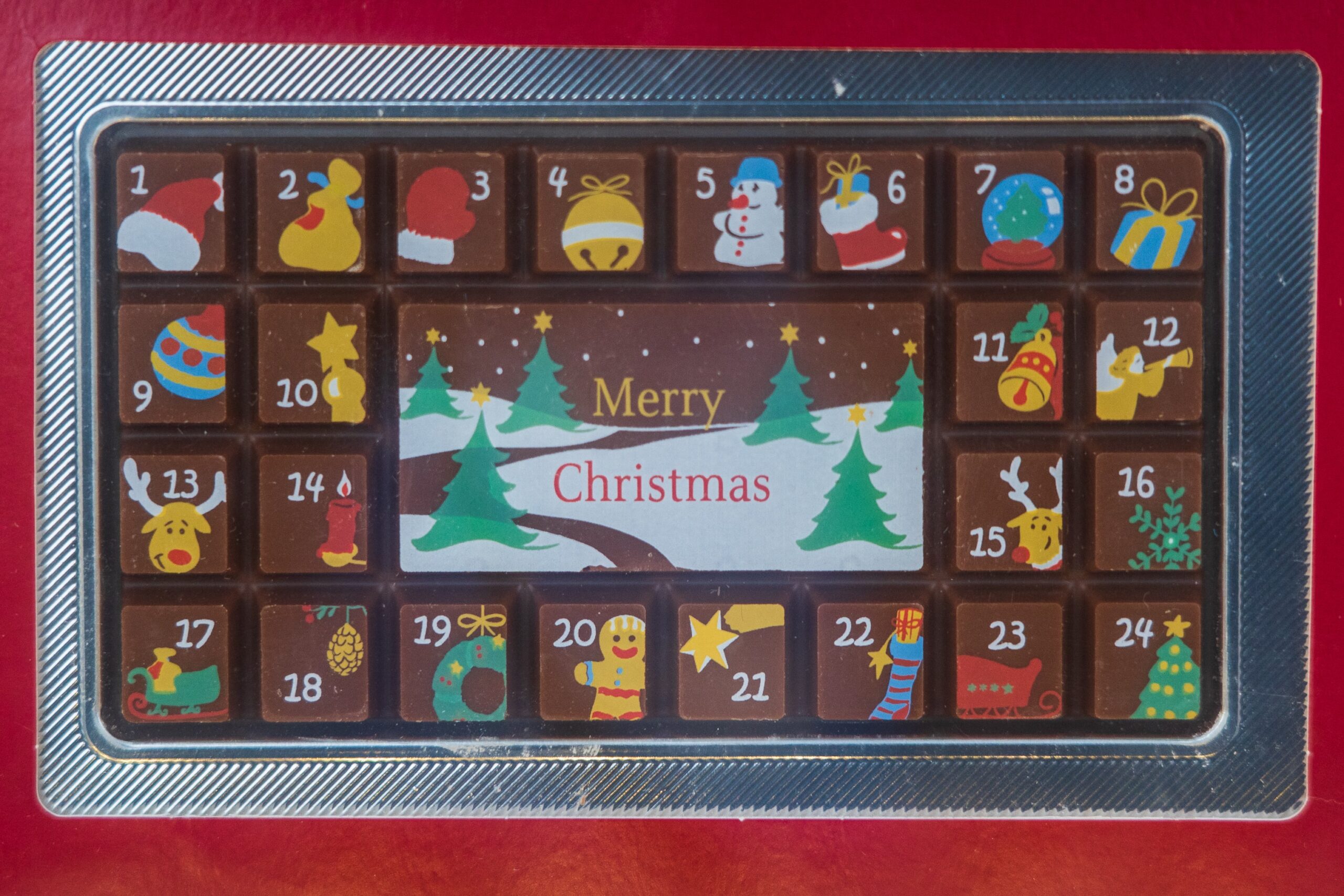
Sustainable advent calendar ideas
An easy way to reduce the waste you create over the holiday season is with alternative ideas for sustainable and plastic-free advent calendars, instead of the traditional varieties. This avoids ending up with plastic and other waste that can’t be recycled on Christmas Day. Consider these sustainable advent calendar ideas:
- DIY advent calendars – the easiest way to have a plastic free advent calendar is to make your own. Use 24 old boxes, jam jars, cans, coffee tins, or anything else you can find for every window. Then fill each with a different gift to avoid creating any packaging waste. Plus, you can recycle all parts come Christmas.
- Beer advent calendars – obviously not for children, but most beer advent calendars are normally plastic free. With a cardboard box you can recycle and each gift a delicious beer in a recyclable metal can or glass bottle, this makes it highly sustainable.
- Seed advent calendars – highly eco-friendly options are seed advent calendars. The packaging is normally paper and cardboard that’s easily recycled, while planting the seeds helps you grow a variety of flowers, plants, and vegetables to keep the planet green.
- Reusable advent calendars – if you don’t have the time or creativity to make your own you could buy a reusable advent calendar. These are normally hung on a wall or door and feature 24 pockets that you can hide your own treats in to further avoid packaging waste. Plus, you can use it again next year, and the one after.
- Candle advent calendar – for something old school, why not go back to a candle advent candle? This could be either a candle you burn down to the relevant number every day or one that you just cross off each day when it burns. You can reuse the jar when it’s all melted away by Christmas.
Interested in more ways to reduce your waste over the festive season? Our detailed waste guides include hints, tricks, and tips for everything from Christmas dinner to gift wrapping and Christmas trees.
Recycling Christmas cards is incredibly easy for both businesses and households. As January arrives, it’s time to take down all those cards with nativity scenes, cartoon reindeers, and dirty Santa jokes (thanks Uncle John), whether they’re from clients, friends, or family. But don’t just chuck them in your general waste bin!
Instead, recycling old Christmas cards should be your first action. The good news is that almost all Christmas cards are recyclable. When it comes to disposing of Christmas cards it’s easy to ensure your home or business is as green as the Christmas tree was when you first put it up (the less said about its browning leaves now, the better).
Discover everything you need to know about recycling Christmas cards and do your bit for the planet in this guide.
For all things relating to Christmas waste including statistics visit our Christmas waste hub.
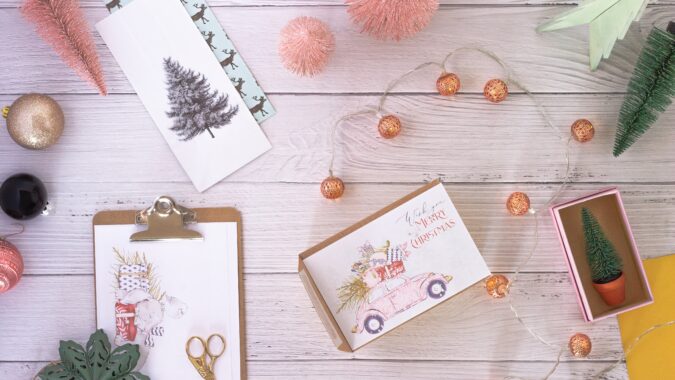
Christmas card
waste facts
Every year millions of Brits get sore hands from writing Christmas cards to workmates we see every day and long-lost university friends we haven’t spoken to in years. And millions of us also get annoyed receiving millions of cards containing mundane round robins and more glitter than you see on a dress from Strictly.
They do add a festive feel to any home or business, but recycling is vital once the holiday season is over. To instill the importance of Christmas card recycling, a few fascinating facts and stats about Christmas card waste are:
- 30,000 tons of Christmas cards are thrown away every year in the UK.
- All the Christmas cards thrown out is equivalent to £2.8 million worth of landfill
- Currently, just one in four Christmas cards are recycled.
- It’s estimated that around 8 billion Christmas cards are sent annually in the UK.
- The average UK household sends 50 Christmas cards each year.
- One tree can be turned into 3,000 Christmas cards.
- Around 500 million Christmas e-cards are also delivered every holiday season.
- Christmas cards are the most poplar of all greetings cards – accounting for 61% of seasonal greeting card sales in the USA.
Can you recycle
Christmas cards?
You can recycle paper-based Christmas and envelopes. Therefore, most traditional Christmas cards are recyclable, and you can put them in your household recycling bin or take them to local recycling points (such as a nearby household waste recycling centre or some supermarkets). However, you must remove any non-paper or card-based additions, such as glitter and foil, to recycle Christmas cards.
You cannot recycle Christmas cards that contain:
- Plastic
- Glitter
- Batteries
- Electronics
- Ribbons
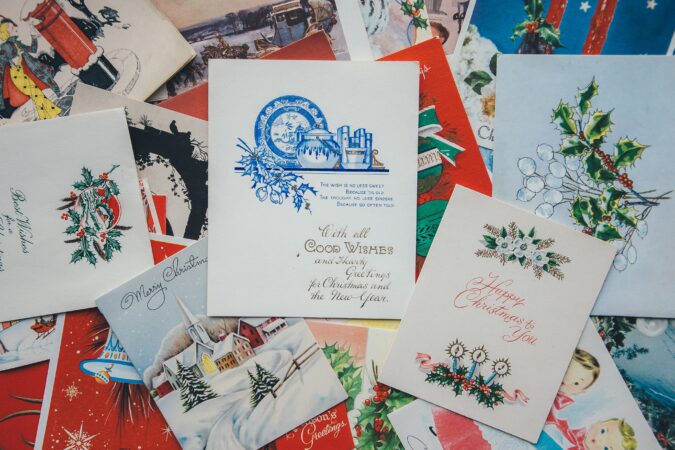
Do Christmas cards go in
paper or cardboard recycling?
Christmas cards can be recycled in either a paper or cardboard recycling bin. As the fibres in paper and cardboard are similar (sharing similar characteristics of wood pulp when broken down), they can be recycled together. Christmas cards are paper based, so you can recycle them with paper, cardboard, or dry mixed recycling.
At home, simply put any Christmas cards in your domestic recycling bin alongside plastic bottles, metal drinks cans, cardboard boxes, and other recyclables. You can also remove and recycle many embellishments some Christmas cards contain, including:
- Batteries – recycle with your WEEE waste or take to a battery recycling point.
- Plastic – any solid bits of plastic can be removed and sent for plastic recycling.
- Glitter and ribbons – unfortunately, these aren’t recyclable, so should be disposed of with your general waste.
Where can I take my
Christmas cards for recycling?
There are a few places you can take old Christmas cards in January for recycling:
- Paper or cardboard recycling bin – commercial cardboard and paper recycling bins at work provide an easy way to recycle your old cards.
- Supermarkets – many supermarkets have specific bins or recycling pints in January to collect Christmas cards for recycling.
- Household waste recycling centres – for local Christmas card recycling visit your nearest household waste recycling centre.
Why should I
recycle Christmas cards?
I’ve already got general waste bins, can’t I just chuck them in there? No – Christmas cards are one of the easiest types of waste to recycle, so you should always put them in your domestic recycling bin or a cardboard or dry mixed recycling bin at work.
It’s the sustainable and responsible option, as the cards can be turned into new paper and card products. This saves on the materials and energy required to create new Christmas cards for next year, reducing carbon emissions that affect global warming.
Plus, for businesses, recycling old Christmas cards saves you money on landfill tax. Throw them away with general waste and they’ll be sent to landfill or for incineration, increasing how much landfill tax you pay. Recycle them with cardboard and dry mixed recycling and you avoid these costs.
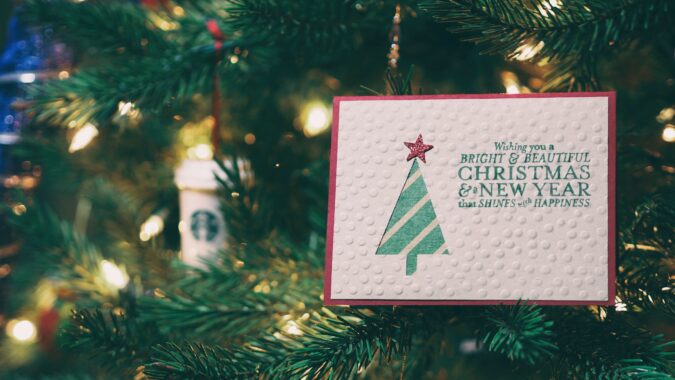
Christmas card
recycling ideas
An old Christmas card still has plenty of life left in it. Aside from recycling it there are many other things you can do with any old Christmas cards you find yourself with in January. A few alternative Christmas card recycling ideas include to:
- Make gift tags – simply cut out any aspect of a Christmas card that would make a good gift tag, punch a hole in the corner, and thread through some ribbon. Get creative and make gift tags in various shapes and sizes.
- Create a collage – cut out any of the designs from your old Christmas cards and arrange them in a picture frame to create an effective festive collage.
- Turn into new cards – don’t just cross out the names and resend. Instead, cut to size any of the images you like and stick on a blank card to make some new Christmas cards ready for next year.
- Use as decorations – cut up the cards into evenly sizes strips and loop them together to make festive paper chains. You could also cut them into shapes and thread them onto some string to form festive bunting.
- Build a puzzle – slice up an old Christmas card into funky shapes to create a fun puzzle for kids and adults. Cut it into as many shapes and sizes as you like for an easy or tricky challenge.
These Christmas card recycling ideas are a great way to reduce the waste you or your business makes over the holiday season. You can find out more ways to minimise the Christmas waste you create in our extensive guides to Christmas waste.
The Christmas tree’s up in the office, the party playlist’s finalised, and the winter wind down at work has well and truly begun. But what’s happening with your business waste collections in December and early January? It might not be at the forefront of your mind, but most companies produce lots more rubbish heading into the year end.
It’s easy to forget about the increases and changes to your waste production and collection needs over the festive period when you get into the seasonal spirit (quite literally at the work Christmas party). Reducing how much commercial waste you create in the run-up to the winter holidays makes managing it much easier – which you can learn about in our guides to Christmas waste.
However, we realise you’ll still produce some amount of rubbish, so it’s important you put in place a plan to deal with it effectively. Use the following tips to tackle your business waste at Christmas with ease.
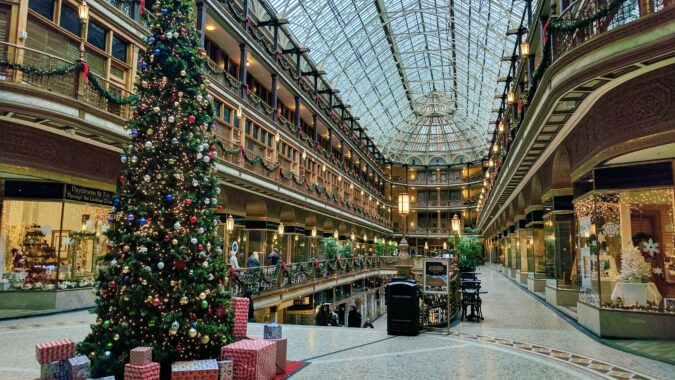
Reduce your commercial
Christmas waste
Preparing for a busy period often means businesses overorder goods and end up with leftover waste in the new year. Do an audit of your orders and waste from previous years for an accurate estimate of how much food, packaging, products, or other items you should order. This can avoid overspending and creating unnecessary waste.
If you’re ordering lots of products or items from the same supplier, do it all in one go to minimise the packaging and fuel used for deliveries. It’s important you consider best before dates for food and have a back-up plan of what to do with any leftovers, so they don’t take up valuable space in your general waste bins.
For companies that don’t rely on ordering goods to operate, you can still reduce waste when it comes to the Christmas party and decorating the office. Everyone likes to overindulge when it comes to festive food and drinks but take a headcount for any event and consider donating leftovers to charity.
Bring forward your
waste collection dates
Will your business be closed for a few days over the Christmas holidays? Then consider moving your waste collection dates earlier to account for this. It’s especially important when you produce more rubbish during this period to avoid it all piling up and sitting there rotting away on the cold dark days and nights.
Dry waste such as cardboard, paper, and metal is fine to leave in secure bins. Other rubbish like food and general waste is best removed and disposed of before your business shuts. If left in your bins for just a few days they’ll start to smell, creating an unpleasant environment for your staff and customers.
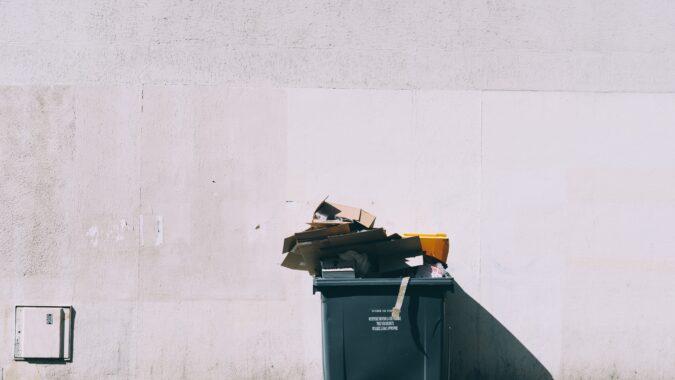
Book extra (festive) bins
More merriment makes more waste! It might just be extra wrappers in the office bin from all the festive food being indulged or additional cardboard from Santa (well, Amazon) gift deliveries at work. The amount of waste you produce increases due to greater demand, especially for restaurants, pubs, bars, hotels, and shops.
Good planning is vital to deal with any waste increases in an efficient and cost-effective way. This avoids being hit with overweight charges for putting too much rubbish in your commercial bins or facing expensive last-minute removal costs to clear the extra waste created.
Check any data you have about your bin collections from the festive period last year for an accurate estimate of how much extra waste you’ll likely produce. Then use this and any other relevant information to order more bins, bigger bins, or increase your collection frequencies for a few weeks.
Some of the common waste types that increase for businesses around Christmas that you might need to order extra or bigger bins for include:
- Cardboard recycling – for all those delivery boxes, advent calendars, and decorations.
- Food waste – leftovers from the Christmas lunch and those extra sweets and treats around the office.
- Packaging recycling – plastic packaging from extra deliveries and festive food.
- General waste – non-recyclables can increase such as packaging and food scraps.
- Glass recycling – drinks bottles from any Christmas celebrations.
Avoid Christmas contamination
It may be easy to just throw any extra rubbish in your general waste bin or slip paper plates covered with Christmas cake crumbs into your paper recycling and hope they go unnoticed. However, this can cause contamination that may mean the entire load is rejected or sent to landfill instead.
Try and recycle or reuse as many seasonal items as possible that your business finds itself with in early January. Check what’s recyclable and arrange delivery of the relevant bins to separate into appropriate streams. This helps the environment and saves you money, by reducing how much landfill tax you’ll pay to get rid of your festive waste.
Recycle the office
Christmas tree
Many businesses go fully festive and decorate offices, restaurants, and shops with a Christmas tree or three. It creates a wonderful wintery atmosphere but come early January, what do you do with them?
The best thing to do if you’ve put up an artificial Christmas tree is keep it for next year, providing you’ve got enough storage space. Otherwise, donate it to a charity shop and they should sell it in time for next Christmas. For any broken trees, you might be able to get rid of it sustainably with your commercial plastic recycling – just check the type of plastic.
Replanting or recycling is advised when you’ve had real trees decorating your business. You can find out what to do with an old Christmas tree that’s real in our detailed guide. Just remember to remove all baubles, tinsel, and decorations before you recycle any Christmas tree!
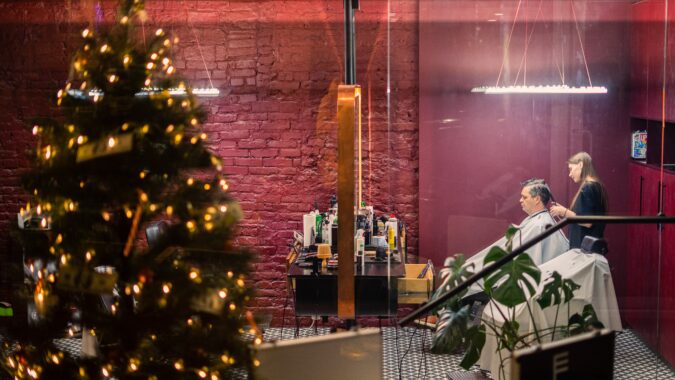
Plan a low waste
Christmas party
A major source of extra commercial waste at winter can be caused by the Christmas party if you host it on your own premises. However carefully you plan it’s likely there’ll be some leftover food, half-drunk bottles of beer and wine, and all the packaging that goes with it.
Prepare by increasing the number and types of bins you need and arrange collection the day after the party to get rid of all waste quickly. Glass recycling bins for all the bottles, extra food waste bins, and general waste collections for all the other rubbish created are some of the main priorities.
Need a hand with your
company’s Christmas waste?
Santa may be generous and deliver plenty of presents over Christmas, but he won’t clear up the waste from your work party, decorations, or festive food. That’s where we come in. At Business Waste, we’re experts at arranging waste collections suited to your specific needs, whatever industry you work in and rubbish type you need disposing.
We provide free bins to businesses anywhere in the country – you just pay for collection. Plus, we work on a zero landfill policy, so aim to recycle as much waste as possible to save you money and help you operate in a way that’s as green as the holly wreath on your door.
Find out how we can help and how much you could save on your Christmas commercial waste collections with a free no obligation quote today. Call 0800 211 8390 or contact us online for a free quote tailored to your waste needs at any time of the year.
Sustainable Christmas gifts are a present to the environment and your loved ones. Every year we buy each other millions of presents that end up in landfill, whether it’s a forgotten plastic toy, unwanted set of teacups, or a jumper that doesn’t fit. There are better ways to recycle and reuse unwanted gifts, but buying environmentally friendly Christmas presents in the first place can help.
But what makes a Christmas gift sustainable? It needs to be something you can reuse, which creates little or zero waste, and that’s biodegradable or compostable. Eco-friendly Christmas gifts are simply those that have barely any environmental impact during their life – from production to their use and disposal.
Protect the planet when planning presents this year with these zero waste Christmas gift ideas.
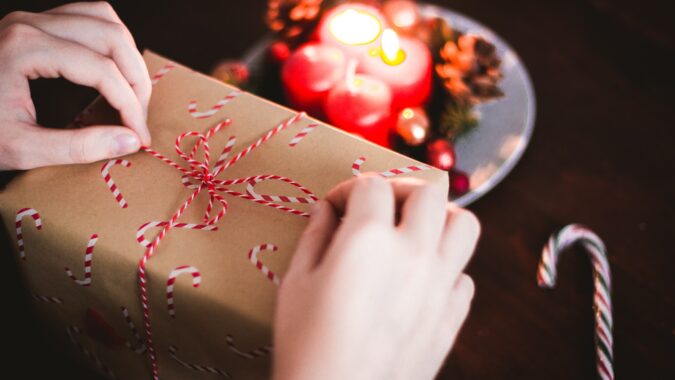
Eco-friendly clothing
For the fashionista in your life there are plenty of great sustainable Christmas presents you can buy – just check what materials any clothing is made from. Purchasing second hand clothes is one of the most eco-friendly choices, but if you want to give something brand new that’s still sustainable, consider the following options:
- Mahabis slippers – a mixture of sustainable, recycled, organic, and responsibly sourced materials are used to make Mahabis slippers. Plus, for each pair you buy a new tree is planted.
- Eco-friendly merino wool scarves – Sheep Inc produce naturally carbon negative scarves from merino wool. This wool is sourced from regenerative farms in New Zealand that use solar-powered, zero-waste Wholegarment® machines.
- Finisterre beanie – Finisterre is a sustainable fashion label that uses natural fibres to make its merino wool beanies. These are soft and warm, while also being renewable, so the fibres can be recycled time and again.
- Organic kids’ clothing – various brands make children’s clothes from organic cotton and other sustainably sourced materials, including Noble, Frugi, and Duns.
- Patagonia – buying clothing gifts from Patagonia helps the planet in various ways as the brand supports environmental non-profit organisations, uses recycled and sustainable materials, and offers a repair and reuse program.
Environmentally friendly
food Christmas presents
Food is a big part of Christmas and makes a great gift. Aside from the packaging, it shouldn’t create much (if any) waste if your recipient enjoys the tasty treats. However, every year we create mountains of food waste over the festive period, so picking out some environmentally friendly Christmas gifts based around food can help. Consider these choices:
- Chocolate – there are many brands producing sustainable chocolate these days from organic and natural ingredients, such as Beyond Good, Motif, and Tony’s. Most also come in recyclable packaging.
- Citizens of Soil olive oil – all the Citizens of Soil olive oil bottles look classy and come in sizes up to 1.5 litres with refill pouches so you can reuse the bottle. The olive oil they contain is sourced from female-led regenerative olive groves and they donate 1% of profits to regeneration projects.
- Seeds gift pack – grow-you-own seeds kits are ideal for that foodie friend with green fingers. You can find kits to use on balconies, in gardens, and even inside to suit all homes.
- Zero waste cookbooks – help your friends and family make their food go further while reducing food waste with one of the various zero waste cookbooks out there. Everything from zero waste meaty meals to vegan dishes, baking, and more are available.
- Beeswax food wraps – cling film is commonly used in the kitchen but problematic as a single-use plastic. These beeswax wraps are a great alternative for that eco-conscious friend who loves to get creative in the kitchen – ideal for wrapping up leftover turkey sandwiches too!
Sustainable Christmas presents
for the home
Environmentally friendly Christmas gifts add a festive feel to any home, while some can be used all year round. Most use natural and sustainable materials rather than plastics that are harder to recycle to create an eco-friendly home. Some of the best sustainable Christmas gifts for the home include:
- Candles – light up a loved one’s home with sustainable candles, such as those from Siblings – non-toxic coconut oil wax in a compostable bag. Simply heat in boiling water and pour into an old jar or container for a plastic and no waste Christmas gift. Or consider a candle making set for a practical and plastic-free present.
- Linen duvet set – linen is light and breathable, which makes it great for bedding. It’s also completely biodegradable and easily recyclable, so one of the world’s most sustainable fabrics.
- Recycled cotton throw – the Sourced by Oxfam collection has a variety of sustainable products including a colourful throw made from recycled cotton, rayon, and polyester. Add a colourful and eco-friendly touch to a loved one’s sofa.
- Handmade wood chopping boards – it’s not Christmas without a cheeseboard, and wood is one of the most sustainable natural materials. Many are made from 100% wood, meaning they can be completely recycled if they break.
- Block soap – many cleaning products contain all sorts of chemicals and come in plastic packaging that’s hard to recycle. Block soap (with a wooden-handled scrubber) makes a great plastic-free alternative for a zero-waste clean of your home.
Homemade sustainable
Christmas gifts
DIY eco-friendly Christmas gifts ensure you give something truly unique, while you can control all the materials used to make them – reducing waste at the source. If crafting isn’t your thing, you can always seek out the assistance of an expert (have a browse on Etsy). Whether you go DIY or enlist someone else’s help, some ideas for homemade sustainable Christmas gifts are:
- Home baking – avoid the packaging that comes with most festive foods by baking your own gingerbread, salted caramel, jams, and chutneys. Reuse any jars and boxes you have to store them. For any non-bakers, try something simple like chocolate orange slices.
- Snow globe – all you need is a clean jam jar, some salt, and a little creativity to build a bespoke snow globe. You could add in a special photo, make a tiny tree, or pop in any unused small toys to craft a Christmas scene.
- Wall hangings – use an old tea towel or some leftover fabric and create a simple yet effective wall hanging by sewing in a message, shape, or other design. It’s a great way to reuse textiles and create a useful home decoration.
- Bath salts – most bath salts include lots of plastic packaging. Instead, make your own with salt, baking soda, essential oils, and a glass jar. Add some dried flowers for an alluring aroma.
- Beeswax candles – roll up a few beeswax sheets and secure them, then add a festive decorative touch to create Christmas candles – without having to melt hot wax.

Looking for more ways to have a low waste Christmas this year? Aside from buying zero waste Christmas presents, there are plenty of other things you can do as a household or business to celebrate the holiday season sustainably.
Sustainable Christmas
presents FAQs
-
How many Christmas presents end up in landfill?
Around one million Christmas presents are thrown away in the UK every year. Research found that around 21 million Brits receive at least one unwanted Christmas present every year. While many are regifted, sold, or donated to charity, sadly around 5% of these are thrown away – meaning they’ll likely make their way to landfill.
-
What can I give instead of Christmas gifts?
There are a few things you can give as an alternative to a physical Christmas gift, such as:
- An experience – such as a spa day, meal out, or racetrack visit.
- Donations to a charity on the receiver’s behalf, ideally one that aligns with their values.
- Your time to do any chores like cleaning the car or mowing the lawn.
- A subscription to a streaming service.
- Host an event, such as a quiz night or movie evening.
-
What do you get an environmentally conscious friend?
Sustainable and zero waste gifts are best for that environmentally conscious friend in your life. Look for items made from natural and sustainable materials that are sourced ethically and create a minimal carbon footprint. This could be anything from reusable bags and storage boxes to biodegradable clothing and phone cases made from recycled plastic.
